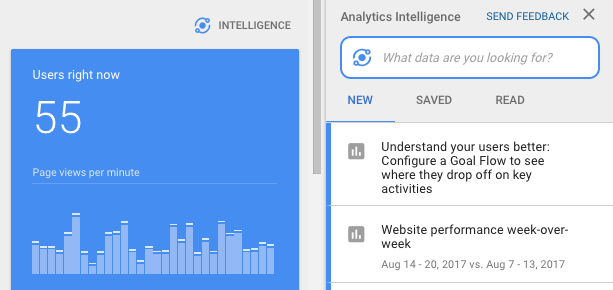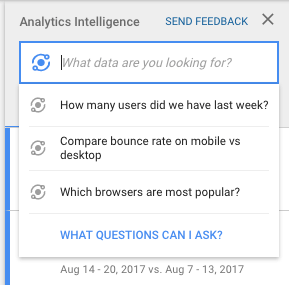Google Analytics Adds “Intelligence” Button
Doug Miller#Digital Marketing, #Industry Insights

Google Analytics has been at the front of data efforts for many organizations and continues to evolve, sometimes at a very rapid pace. Here's another new tool:
It seems that every day new changes arrive that allow us to have more and more data about our businesses and ourselves online. For years, Google products have been at the front of those efforts for many organizations and each continues to evolve, sometimes at a very rapid pace. I do my best to stay on top of those changes, so that I can curate information about them out to others. In this post, I want to talk about a feature set called Google Analytics Intelligence. Recently, Google implemented a few changes to Google Analytics that are very noteworthy around some tools that should make it easier to use Google Analytics. What began as a feature of the mobile version of the Google Analytics environment has now made its way to the desktop environment.
Notifications vs. Intelligence
If you use Google Analytics on a semi-regular basis, you probably are aware of the fact that there is a notification center in the upper right-hand corner of the interface. This notification center will give webmasters, marketers, content analysts, or whoever has access to a particular digital property in Google Analytics, some insight into how the account is performing with alerts and recommendations for action and note. It has been that way for a while, and while some of the recommendations that appear there are certainly more relevant to certain audiences than others, it was all useful information.
That information continues and has been given some new life with the desktop version of the Analytics Intelligence interface. To find it, just look for the new button on the right of your interface that says "intelligence." Once there, you may see alerts as to activities that need to happen for improved data gathering, but also highlights of positive momentum in your traffic trends, and even a fancy new way to interact I'll discuss later in the blog.

The first thing I think makes this new interface great is that users will now see more actionable items that lead to specific reports within the Google Analytics environment. For example, rather than just get a notification that there is an error with tracking or a red flag with traffic, Google's new interface will let users know when things are working well, like if a particular page shows an increase in traffic or conversions, and provide a direct link to that report within the platform.
Report Wayfinding
That last bit is a big win for many users of Google Analytics. I've been working with the product for more than a few years now, and I'm always encountering individuals at organizations who know they have Google Analytics, but who don't know how to use Google Analytics to help their organization's efforts, or find the interface, with all the many possible data points to examine, too overwhelming to navigate usefully.
I go out of my way to help organizations set up the tool and make sure it is collecting data the way they want, and to help them figure out how best to get reporting about that data into their organization's conversations as efficiently as possible. It isn't easy for any organization. Often just finding and reporting on those key data moments can be a very time intensive challenge, and if it is only one of the many hats you wear, it often falls to the bottom of the triage list since it "isn't broken".
This new interface, with the alert that directly points to the place inside the reporting tool that is relevant to the event, should make that process a lot less cumbersome for many users. Having the alert offer a direct link to the relevant report, however, is only the beginning of the ways this new interface has been designed to make the whole product more approachable for a wider array of data stakeholders.
Natural Language Questions
One of the most exciting things that computers are able to do now is to understand our questions when they are phrased as though we are asking a colleague or a friend. To be able to use natural language instead of having to phrase the question in a manner that a machine would understand is a big change and likely to be a part of most conversations about user experience for some time to come.
It is no surprise that Google is, again, among the early forces moving this into reality. I had a chance to test the interface when it was available earlier in the mobile app, but I didn't write about it because, by my experience, only the really advanced users of the Google Analytics tool had workflows that required (or allowed for) use in a mobile context. I was a bit confused why Google would choose to limit release to the mobile interface and not allow the desktop interface. Either way, I believe that moving it to the desktop environment will allow a greater number of data stakeholders to improve their workflows with this new interface and I’m glad to see it.
The results are almost magical. There have been many times in my work experience when someone would come to me and ask a semi-vague, natural language question about organizational data gathered in GA and end it asking if we could report on it.
With this new interface, it is possible to type natural language questions looking for the right combination of data and to have the AI fielding those questions (remember, what makes AI unique as opposed to just a bot that returns results based on search query terms is that it understands your question and learns from what you asked – it grows in its understanding) lead you in the right direction. For more on the types of questions you can ask Google Analytics Intelligence, Google has put together some suggestions.

This is a big leap forward in functionality for the tool and a great way to make the tool more approachable to those who are not as easily inclined to be able to navigate the depths of possibilities available. As it evolves, I'm certain that it will be even more important to have the tool digesting the proper data points, and I predict that the result is likely to require that more organizations will need close data partners to ensure their digital properties are gathering the data the way they expect to maximize usefulness.
I'm happy to have a conversation with you about your use of the Google Analytics tool and to provide some recommendations for how to make it a more approachable and useful experience with these new trends. Leave a note in the comments below or over social with questions you might have.
Related Posts

Making ChatGPT Sound More Human – Guidance for Writers
ChatGPT is an innovative platform for enhancing your writing, but here are a few ways to help from losing your “voice” while using it...

3 Reasons Your Business Needs to Focus on Customer Experience
While there are many reasons why companies should focus on customer experience, here are three timely reasons that should be top of mind for any marketer.
Results Matter.
We design creative digital solutions that grow your business, strengthen your brand and engage your audience. Our team blends creativity with insights, analytics and technology to deliver beauty, function, accessibility and most of all, ROI. Do you have a project you want to discuss?
Like what you read?
Subscribe to our blog "Diagram Views" for the latest trends in web design, inbound marketing and mobile strategy.
